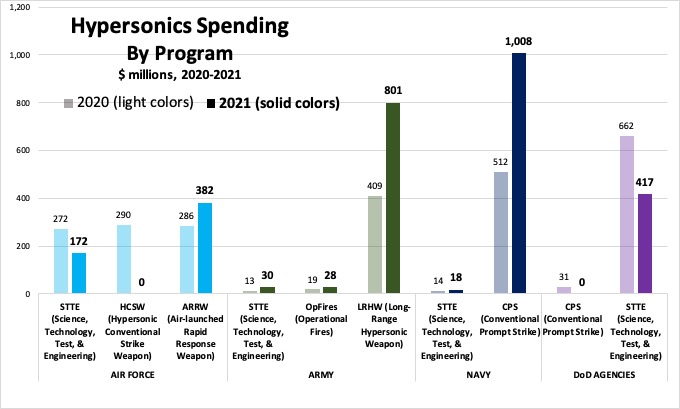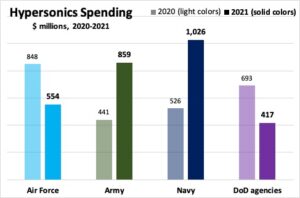“We want to deliver hypersonics at scale,” said R&D director Mark Lewis, from air-breathing cruise missiles to rocket-boosted gliders that fly through space.
By SYDNEY J. FREEDBERG JR.
WASHINGTON: The Pentagon has created a “war room” to ramp up production of hypersonic weapons from a handful of prototypes over the last decade to “hundreds of weapons” in the near future, a senior official said Wednesday. Those weapons will range from huge rocket-powered boost-glide missiles, fired from Army trucks and Navy submarines at more than Mach 10, to more compact and affordable air-breathing cruise missiles, fired from aircraft at a relatively modest Mach 5-plus.
“It isn't an either-or,” said Mark Lewis, modernization director for Pentagon R&D chief Mike Griffin. “It isn't rocket-boost or air-breathing, we actually want both, because those systems do different things.”
Right now, however, US combat units have neither. Inconsistent focus and funding over the years means that “we had a number of programs in the department that were very solid technology development programs, but at the end of those programs, we would have prototypes and we'd have weapons in the single-digit counts,” Lewis said during a webcast with the Air Force Association's Mitchell Institute. “If you've got a program that delivers eight missiles and then stops, well, which of the thousand targets in our target set are we going to use those eight missiles against?”
With hypersonics now a top priority for both Undersecretary Griffin and Defense Secretary Mark Esper, the Pentagon is trying to improve that stop-and-go track record with a new “hypersonic acceleration plan” – no pun intended, Lewis said. Griffin likes to compare the effort to the Cold War, when the US had a massive nuclear weapons infrastructure capable of building complex components by the tens of thousands.
“We want to deliver hypersonics at scale,” Lewis said. “That means hundreds of weapons in a short period of time in the hands of the warfighter.”
Mass-production, in turn, requires production facilities – but today hypersonic prototypes are basically hand-crafted by R&D labs like Sandia. Lewis and his counterpart in the Pentagon's acquisition & sustainment directorate, Kevin Fahey, are “co-chairing what we're were calling a war room ... looking at the hypersonic industrial base,” he said. “That's not just the primes, but the entire industrial base” down to small, specialized suppliers.
Controlling cost is both essential to large-scale production and a huge challenge, Lewis acknowledged. “We don't know what these things cost yet,” he said. “We've asked the primes to consider costs as they're developing.”
Which hypersonic weapons the Pentagon buys also makes a major difference. “There are some technology choices we can make that lead us to more cost-effective systems,” he said. “I'm especially enthusiastic about hypersonic weapons that come off the wings of airplanes and come out of bomb bays, [because] I think those are some of the keys to delivering hypersonic capabilities at scale and moderate cost.”
Likewise, “[there's] larger investment now in the rocket boost systems,” Lewis said, “[but] one of the reasons I'm so enthusiastic about scramjet-powered systems, air-breathing systems is I think that, fundamentally, they can be lower-cost than their rocket-boosted alternatives.”
Why is that? Understanding the policy, it turns out, requires a basic understanding of the physics.

Breaking Defense graphic from DoD data
Four Types of Hypersonics
“Hypersonics isn't a single thing,” Lewis said. “It's a range of applications, a range of attributes, [defined by] the combination of speed and maneuverability and trajectory.”
To put it in simple terms – and I'll beg the forgiveness of any aerospace engineers reading this – there are two kinds of hypersonic projectile, based on how they fly: one is an air-breathing engine flying through the atmosphere, like a jet plane or cruise missile; the other is a rocket booster arcing to the edge of space, like an ICBM. There are also two kinds of platform you can launch from: an aircraft in flight high and fast above the earth, or a relatively slow-moving vehicle on or below the surface, like an Army truck, Navy warship or submarine.
Combine these and you get four types. Lewis thinks all four could be worth pursuing, although the Pentagon currently has programs – that we know about – for only three:
- Air-launched boost-glide: Air Force ARRW (Air-launched Rapid Response Weapon). The Air Force also had another program in this category, HCSW (Hypersonic Conventional Strike Weapon), but they canceled it to focus on ARRW, which the service considers more innovative and promising.
- Surface-launched boost-glide: Army LRHW (Long Range Hypersonic Weapon) and Navy CPS (Conventional Prompt Strike). Both weapons share the same rocket booster, built by the Navy, and the same Common Hypersonic Glide Body, built by the Army, but one tailors the package to launch from a wheeled vehicle and the other from a submarine.
- Air-launched air-breathing: HAWC (Hypersonic Air-breathing Weapons Concept) and HSW-ab (Hypersonic Strike Weapon-air breathing). Arguably the most challenging and cutting-edge technology, these programs are both currently run by DARPA, which specializes in high-risk, high-return research, but they'll be handed over to the Air Force when they mature.
- Surface-launched air-breathing: This is the one category not in development – at least not in the unclassified world. But Lewis said, “eventually, you could see some ground-launched air breathers as well. I personally think those are very promising.”
Each of these has its own advantages and disadvantages, Lewis explained.
Rocket boosters are proven technology, offering tremendous speed and range. The Minuteman III ICBM, introduced in 1970, can travel over 6,000 miles at Mach 23. Their one drawback is that ICBMs can't steer. Once launched, they follow a predictable course like a cannon ball, which is why they're called ballistic missiles. The big innovation of boost-glide weaponry is that it replaces the traditional warhead with an agile glider. Once the rocket booster burns out, the glide body detaches and coasts the rest of the way, skipping nimbly across the upper layers of the atmosphere like a stone across the pond.
But boost-glide has some big limitations. First, once the rocket booster detaches, the glide body has no engine of its own so it just coasts, losing speed throughout its flight. Second, precisely because the rocket launch is so powerful, it puts tremendous strain on the weapon, whose delicate electronics must be hardened against shock and heat. Third, the booster is big, because a rocket not only has to carry fuel, it has to carry tanks of oxygen to burn the fuel.

Breaking Defense graphic from DoD data
An air-breathing engine, by contrast, can be significantly smaller. It just has to carry the fuel, because it can scoop up all the oxygen it needs from the atmosphere. That means the whole weapon can be smaller, making it much easier to fit on an aircraft, and that it can accelerate freely during flight instead of just coasting, making it more maneuverable.
But while conventional jet engines are well-proven technology, they don't function at hypersonic speeds, because the airflow pours their intakes far too fast. So you need a sophisticated alternative such as a scramjet, a complex, costly technology so far found only on experimental vehicles, like the Air Force's revolutionary Boeing X-51.
Even with a scramjet, you can't fly too high because the air doesn't provide the needed oxygen. That means air-breathing weapons can't reach the same near-space altitudes as boost-glide missiles. They also can't fly nearly as fast. Lewis expects air-breathers will probably top out around Mach 7, half or less the peak speed of a boost-glide weapon. (That said, remember the glider will have slowed down somewhat by the time it reaches the target).

Sandia National Laboratories glide vehicle, the ancestor of the Army-built Common Hypersonic Glide Body
The platform you launch from also has a major impact on performance. Warships, submarines, and long-bodied heavy trucks can carry bigger weapons than aircraft, but the weapons they carry need to be bigger because they have to start from low altitude and low speed and go all the way to high-altitude hypersonic flight. By contrast, an air-launched weapon doesn't need to be as big, because it's already flying high and fast even before it turns on its motor.
All these factors suggest that the big boost-glide weapons are probably best launched from land or sea, the smaller air-breathing ones from aircraft in flight. But since boost-gliders go farther and faster than air-breathers, you still want them as an option for your bombers for certain targets. On the flipside, while a naval vessel or ground vehicle has plenty of room to carry boost-glide weapons for ultra-long-range strikes, it can also use the same space to carry a larger number of the smaller air-breathers for closer targets.
“We're interested in basically the full range,” Lewis said. “We've got some ideas of things we want to put into play quickly, but we're also extremely open-minded about future applications, future technologies.”
https://breakingdefense.com/2020/04/hypersonics-dod-wants-hundreds-of-weapons-asap/



